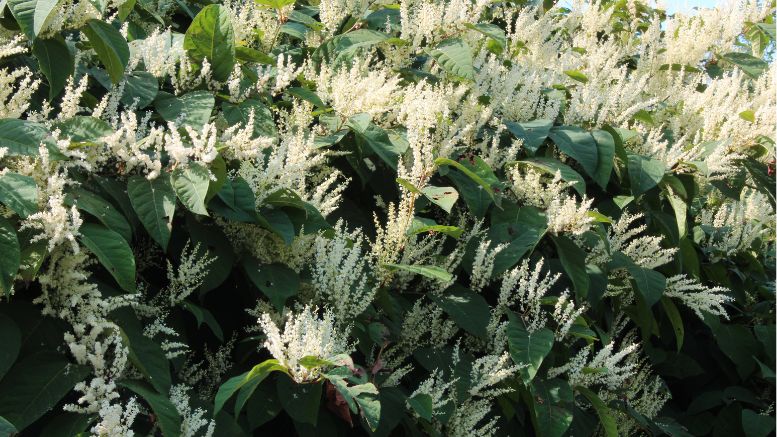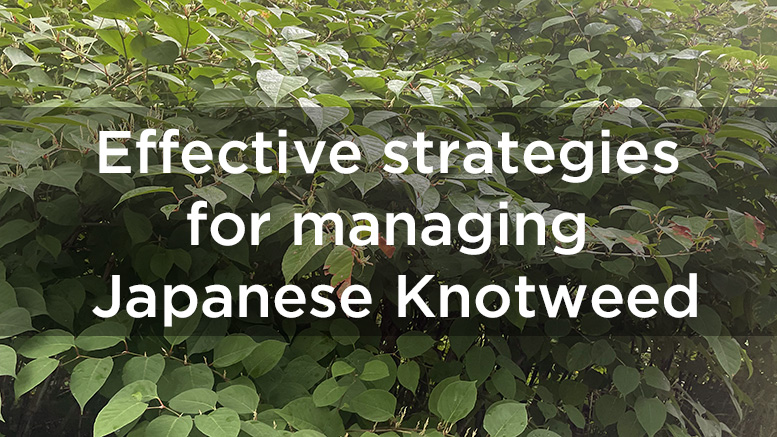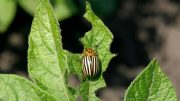Effective strategies for managing Japanese Knotweed: Timing and techniques
In the world of invasive plants, Japanese knotweed (Reynoutria japonica) is a formidable adversary.
Its rapid growth and tenacity make it a challenging enemy for homeowners and gardeners alike. But fear not, armed with the right knowledge and techniques, you can effectively manage and control this invasive bamboo-like plant.
Don’t do this:
Many homeowners, myself included, use techniques like mowing, cutting, smothering, and digging, in an attempt to get rid of this yard-wrecker.
Because knotweed evolved to grow, literally, on volcanos, the plant perceives any of the above techniques as a threat. Thus, instead of doing us all a favor and dying, it actually shoots out new roots as a defense, becoming even more powerful!
Avoid mowing
One common mistake is mowing knotweed, thinking it will control its growth. However, knotweed can grow from any intact node on its living canes. Instead of mowing, consider snipping mid-summer on older stems to keep them shorter for a fall application of glyphosate, a widely used herbicide.
Beware of underground growth
Cutting or pulling up the above-ground growth may seem like a logical solution, but it can backfire. These actions can trigger aggressive underground growth, resulting in the plant divert using its remaining energy to send out invasive rhizomes, making the problem even more challenging.
And once that happens, each one of the plant’s underground rhizomes can spread up to 200 feet, according to the University of Massachusetts Amherst Center for Agriculture, Food and the Environment.
The ineffectiveness of burning and pulling
Burning knotweed does little to control its growth, and pulling it can actually make the plant more aggressive. These methods should be avoided in favor of targeted herbicide application.
Digging is an expensive and risky solution
YES, you can try digging it out. We have tried this in our yard.
The problem with digging is:
1) You have to get literally every single shred of knotweed out of your yard. This is almost impossible. A 1/2″ scrap of knotweed will set down new roots literally within days.
2) You have to take the infected fill and dump it somewhere, where it may spread… more knotweed. Because guess what can’t kill knotweed? Contractor bags. Even if you bag it up and put it in the trash, there is a very good chance parts of it will live – and spread. Maybe not near you. But somewhere else.
3) After you dig and remove the knotweed, you have to fill that dug-out space with clean dirt. And reseed, replant, etc.
This is expensive. Like, potentially six figure thousands of dollars expensive, depending on the size of your yard.
And unless it is done 100% perfectly, it might not be a permanent solution.
Knotweed can potentially decrease your property value
A lawsuit involving the spread of Japanese knotweed in a Pepperell family’s yard resulted in a judgment of over $300,000 against a developer in March. The developer was accused of spreading soil containing this invasive plant in the family’s yard in 2017, and the case has raised questions about state laws regarding such invasive species.
Instead, do this:
Spray with an herbicide, but only one time per year
I KNOW, I KNOW. Nobody wants to use Roundup. I definitely do not want to use Roundup.
However, unless you want knotweed to take over everything, you must accept that one annual treatment is necessary. A single annual treatment can reduce the size of your knotweed by up to 80%! So, this year if it’s 6′, it might be 1′ or 2′ next year! You’ll probably have to treat it one or two more times (a 3 year process), but after that, it should go dormant.
Then, you can keep your beautiful pollinator-loving plants and bushes.
Pretty much everything you do to combat knotweed will result in the knotweed GETTING STRONGER. Cutting, smothering, mowing, burning, adding mesh, etc. DO NOT work as any sort of permanent solution. They cause the knotweed to put out more roots, making spread.
Timing is key – use the F-ing Window

Japanese knotweed in its flowering state.
You want to attack the plant when it’s in its most vulnerable state. Timing is crucial. Spray during the “flowering window.”
You must spray with 2-5% glyphosate when the plant is flowering (ideally toward the end of the flowering season) but before the first frost. In New England, this usually begins in late August through September, and possibly into October.
During this period, the plant is focused on its above-ground growth. In the fall, it naturally starts diverting energy and nutrients into its rhizome network for winter storage. Spraying the leaves at this stage forces the plant to draw the chemicals quickly underground, putting a huge halt to its growth.
The science of absorption
Understanding how knotweed absorbs herbicides is crucial. Injecting the poison into the stem is less effective because nutrients are not pulled down via the inner hollow portion but the cell wall.
Spraying it directly onto the plant where the herbicide is absorbed through the leaves, is more efficient. Interestingly, you don’t need to spray the leaves; green stems can also absorb glyphosate effectively. Even treating the stems from a height of one yard down can be a successful approach.
Cutting: Know when and why
Only cut if the plant has become too tall to spray the leaves effectively in the fall.
Younger plants may not require cutting at all. Cutting the plant prematurely can actually make the situation worse by stimulate aggressive underground growth from the invasive rhizomes.
While injection may be recommended if you need to protect against overspray, it’s generally more labor-intensive and less effective than properly timed foliar spray. Additionally, injection can give a false sense of hope by disrupting dormancy without effectively controlling the plant.
Once the injected stems have completely died and dried out, you can cut them off and dispose of them in the trash (not yard waste).
Japanese knotweed can be a persistent invader, but with the right strategies and timing, you can successfully manage and control its growth.
Remember that cutting and mowing should be done judiciously, and foliar application of 2-4% glyphosate during the right season is often the most effective approach. By following these guidelines, you can reclaim your green space from the grasp of this invasive plant.
Getting help
I highly encourage you to follow Japanese Knotweed Behavior and Information and join the Worldwide Japanese Knotweed Support Group on Facebook for more information.
I have learned so much about Japanese Knotweed in this group, including that everything I was doing to eradicate it was wrong!
– Contributed by Melissa Fassel Dunn.






Be the first to comment on "Effective strategies for managing Japanese Knotweed: Timing and techniques"